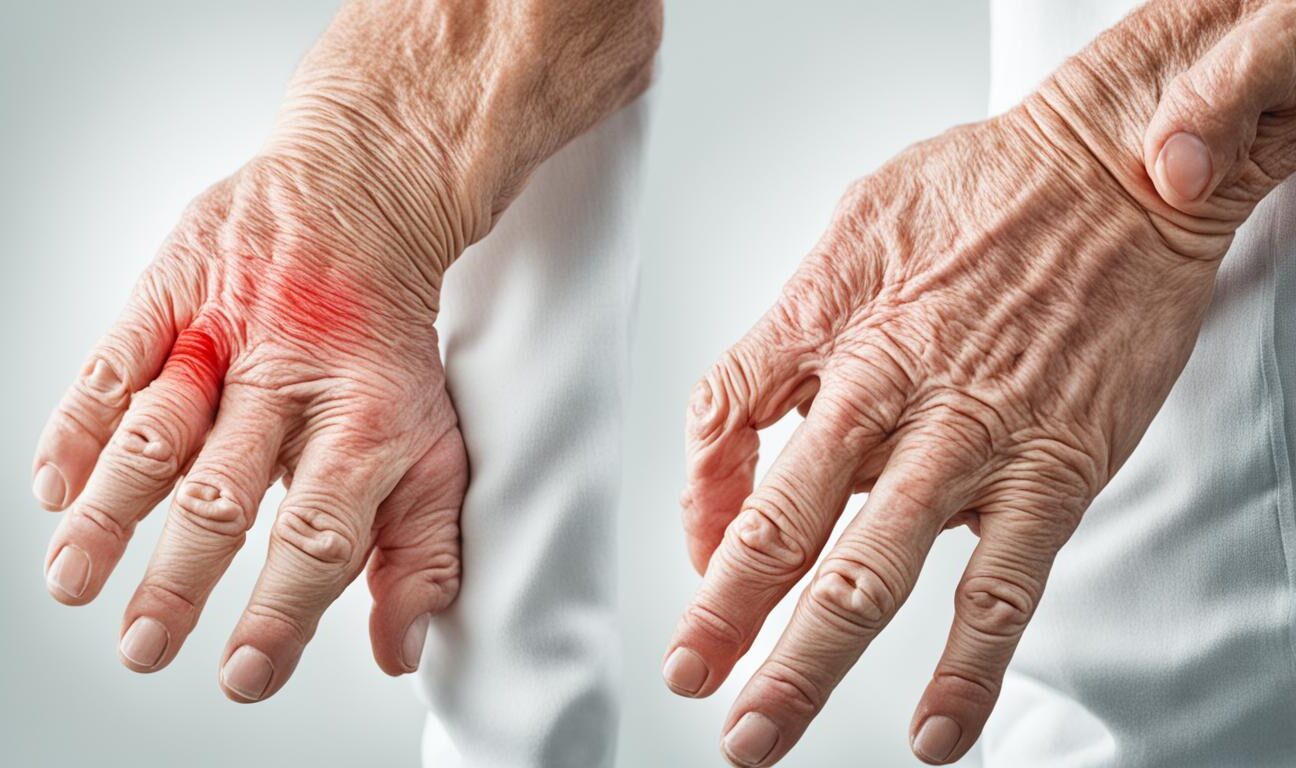Living with arthritis means facing daily challenges. It’s a condition that causes joint pain and stiffness. But, there’s hope for relief. This guide will cover the best ways to ease arthritis pain, including medicines, natural remedies, and lifestyle changes.
Key Takeaways
- Discover the different types of arthritis and their common symptoms
- Learn about over-the-counter and prescription medications for arthritis pain relief
- Explore natural and herbal supplements that can help manage joint inflammation
- Understand the importance of exercise, physical therapy, and weight management for arthritis
- Discover complementary and alternative therapies, such as acupuncture and massage, for arthritis pain relief
Understanding Arthritis and Its Impact
Arthritis is a condition that affects the joints, causing pain, stiffness, and inflammation. It’s important to know the different types of arthritis and their symptoms to manage it well.
Types of Arthritis and Common Symptoms
Osteoarthritis and rheumatoid arthritis are the most common types. Osteoarthritis is a disease that happens when cartilage wears down over time, usually in older people. It leads to pain, stiffness, and less movement in the joints.
Rheumatoid arthritis is an autoimmune disorder that can strike at any age. It makes the immune system attack the joints, causing inflammation, pain, and joint shape changes.
| Arthritis Type | Symptoms |
|---|---|
| Osteoarthritis |
|
| Rheumatoid Arthritis |
|
The Importance of Proactive Pain Management
Managing arthritis pain is key to keeping joints healthy and improving life quality. Taking steps like using anti-inflammatory drugs, physical therapy, and changing your lifestyle can lessen symptoms and stop further damage. By being proactive with arthritis pain management, people can live more actively and happily.
“The key to managing arthritis pain is to address it early and consistently. With the right treatment plan, many individuals with arthritis can maintain their mobility and independence.”
Medications for Arthritis Pain Relief
Arthritis can make life hard, but there are ways to ease the pain. It’s key to know about different anti-inflammatory drugs and arthritis medications. This knowledge helps in choosing the right treatment.
Over-the-Counter Anti-Inflammatory Drugs
NSAIDs like ibuprofen and naproxen help with arthritis pain and swelling. These anti-inflammatory medications work for mild to moderate arthritis. But, they can have side effects, especially if taken for a long time.
Prescription Arthritis Medications
For severe arthritis, arthritis prescription drugs might be needed. These include stronger NSAIDs, corticosteroids, and DMARDs like methotrexate. These drugs can help a lot but have more side effects and need a doctor’s watchful eye.
| Medication Type | Examples | Potential Benefits | Potential Risks |
|---|---|---|---|
| Over-the-Counter NSAIDs | Ibuprofen, Naproxen | Reduce inflammation and pain | Stomach ulcers, kidney problems, increased risk of heart attack or stroke with long-term use |
| Prescription NSAIDs | Celecoxib, Meloxicam | Stronger anti-inflammatory effects | Similar risks as over-the-counter NSAIDs, plus potential for more severe side effects |
| Corticosteroids | Prednisone, Methylprednisolone | Rapid reduction in inflammation and pain | Weight gain, osteoporosis, high blood pressure, diabetes, and increased risk of infection with long-term use |
| DMARDs | Methotrexate, Hydroxychloroquine | Slow the progression of joint damage | Potential liver or kidney toxicity, increased risk of infection |
It’s crucial to talk with a healthcare provider to find the right anti-inflammatory medication or arthritis prescription drugs. This depends on the type and severity of arthritis, and on your personal health and preferences.

arthritis pain relief, arthritis treatments, joint pain
Dealing with arthritis and its joint pain can be tough. Luckily, there are many ways to help manage this condition. We’ll look at both traditional and new therapies for easing arthritis pain.
Conventional Arthritis Treatments
For quick relief, over-the-counter painkillers like ibuprofen and naproxen can help. Prescription drugs, including DMARDs and biologic agents, are also used. They aim to reduce inflammation and manage the condition.
Alternative Arthritis Therapies
Many people find relief with alternative therapies. These include supplements, yoga, meditation, and physical therapy. These methods can help with pain and improve overall health.
| Treatment | Description | Potential Benefits |
|---|---|---|
| Acupuncture | The insertion of thin needles into specific points on the body to stimulate the flow of energy and reduce pain. | May help alleviate joint pain and stiffness associated with arthritis. |
| Massage Therapy | The manipulation of soft tissues, such as muscles and tendons, to promote relaxation and reduce pain. | Can help improve joint mobility and reduce muscle tension in individuals with arthritis. |
| Tai Chi | A gentle, low-impact form of exercise that combines slow, flowing movements with deep breathing and meditation. | May improve balance, flexibility, and overall joint function in people with arthritis. |
Understanding all the options for arthritis pain relief helps people work with their doctors. Together, they can create a plan that suits their needs and improves their life.

“The key to managing arthritis is to find a combination of therapies that work best for your individual needs and lifestyle.”
Natural Remedies for Arthritis Pain
Many people are now looking at natural and holistic ways to help with arthritis pain. These methods offer a softer approach to relief and better overall health.
Herbal and Dietary Supplements
Some herbs and supplements can help with arthritis symptoms. Natural arthritis remedies like ginger, turmeric, and boswellia can lessen inflammation and make joint pain better. Arthritis supplements with glucosamine and chondroitin might also help with joint function and movement.
- Ginger: Known for its anti-inflammatory properties, ginger can be consumed in supplement form or added to meals and beverages.
- Turmeric: The active compound curcumin in turmeric has been studied for its ability to reduce inflammation and ease joint discomfort.
- Boswellia: This herb has been used in traditional medicine to address inflammation and joint pain associated with arthritis.
- Glucosamine and chondroitin: These supplements may help to rebuild and protect the cartilage in the joints.
Mind-Body Therapies for Arthritis Relief
Mind-body therapies for arthritis can help with pain and overall well-being. Techniques like meditation, yoga, and acupuncture can lessen stress, improve flexibility, and help the body naturally reduce pain.
- Meditation: Regular meditation can help to alleviate the physical and emotional toll of chronic joint pain.
- Yoga: Gentle, low-impact yoga poses can improve joint mobility and muscle strength, while also promoting relaxation.
- Acupuncture: This traditional Chinese medicine technique may help to reduce inflammation and pain by stimulating specific points on the body.
Adding these natural remedies to your arthritis care can give you a full approach to relief and better life quality.

Exercise and Physical Therapy
Arthritis can make daily life tough, but exercise and physical therapy can help. Low-impact exercises are great for improving joint movement and easing pain. They don’t put too much strain on the joints.
Low-Impact Exercises for Joint Mobility
Finding the right exercises is key when you have arthritis. Here are some top low-impact options:
- Walking: It’s easy and helps with heart health and joint movement.
- Swimming: This exercise works your whole body without stressing your joints.
- Cycling: It strengthens muscles around the joints without too much pressure.
- Tai Chi: This slow, flowing martial art boosts flexibility, balance, and joint movement.
- Strength training: Using light weights or resistance bands can help build muscle and support your joints.
It’s crucial to work with a physical therapist or doctor to create an exercise plan that fits your needs. With the right exercises and guidance, people with arthritis can keep their joints moving well and feel less pain.

| Exercise | Benefits for Arthritis | Precautions |
|---|---|---|
| Walking | Improves cardiovascular health, joint function | Avoid high-impact activities, use proper footwear |
| Swimming | Full-body workout without weight-bearing stress | Avoid extreme temperature changes, maintain proper form |
| Cycling | Strengthens muscles without putting pressure on joints | Use a comfortable, supportive bike, avoid hills |
| Tai Chi | Improves flexibility, balance, and joint mobility | Start with gentle, low-intensity movements |
| Strength Training | Builds muscle to support joints | Use light weights and focus on proper form |
Lifestyle Modifications for Arthritis Management
Living with arthritis can be tough, but making smart lifestyle changes helps a lot. By focusing on weight and stress, you can help manage your joint pain and inflammation. This way, you take charge of your arthritis symptoms and improve your health.
Weight Management and Arthritis
Keeping a healthy weight is key for arthritis sufferers. Carrying extra weight puts more stress on your joints, making pain worse and harming joint health. By managing your weight, you can ease the strain on your joints and feel better.
- Eat a balanced diet full of fruits, veggies, whole grains, and lean meats to help with weight control.
- Try low-impact exercises like swimming, cycling, or walking to lose weight and strengthen your joint-supporting muscles.
- Team up with a healthcare provider or dietitian to create a personalized plan for arthritis that fits your needs and goals.
Putting weight management for arthritis first can greatly reduce joint strain. This leads to a better life overall.

“Achieving and maintaining a healthy weight can make a world of difference for individuals living with arthritis. It’s a simple, yet powerful, step towards better joint health and reduced pain.”
Complementary and Alternative Therapies
Many people use treatments beyond traditional medicine to help with arthritis pain. Acupuncture and massage are two popular options. They aim to ease arthritis symptoms.
Acupuncture for Arthritis Pain
Acupuncture is becoming more popular for arthritis. It’s an ancient Chinese method that uses thin needles to help the body heal. Studies show it can lessen pain and make moving easier for people with arthritis.
Massage for Arthritis Relief
Massage is another way to help with arthritis pain. It uses gentle techniques to improve blood flow and relax muscles. Many find that massage, along with other treatments, makes living with arthritis better.
| Therapy | Potential Benefits | Considerations |
|---|---|---|
| Acupuncture |
|
|
| Massage |
|
|
Acupuncture and massage can be useful alongside traditional treatments for arthritis. But, they shouldn’t replace medical care. Always talk to a healthcare provider before trying new therapies. They can help make sure the treatment is safe and right for you.

Managing Rheumatoid Arthritis Flare-Ups
Living with rheumatoid arthritis has its challenges, especially when it comes to flare-ups. These are sudden increases in pain, swelling, and inflammation in your joints. But, with the right strategies, you can handle these flare-ups and keep your life on track.
Managing flare-ups often means changing your medication plan. Your doctor might suggest upping your anti-inflammatory or corticosteroid doses to lessen inflammation and ease pain. It’s important to work closely with your rheumatologist to find the right mix of medications for you.
Changing your lifestyle can also help manage flare-ups. Try doing gentle exercises like swimming or tai chi to keep your joints moving and reduce inflammation. Also, stress-reducing activities like meditation or deep breathing can help you deal with the emotional and physical effects of a flare-up.
“The key to managing rheumatoid arthritis flare-ups is to be proactive and work closely with your healthcare team to find the right combination of treatments that work for you.”
Everyone with rheumatoid arthritis is different, so what works for one person might not work for another. By staying alert, talking with your healthcare providers, and trying different approaches, you can learn to manage your flare-ups and take charge of your health.

Osteoarthritis: Treatments and Prevention
Osteoarthritis is the most common type of arthritis. It can make life hard for millions of people around the world. But, there are many ways to handle this joint problem.
Joint Replacement Surgery: When Is It Necessary?
For those with severe osteoarthritis, surgery might be an option. This surgery replaces the worn-out joint with an artificial one. It’s usually done when other treatments like medicines, physical therapy, and changing your lifestyle don’t help enough.
- Severe, chronic joint pain that interferes with daily activities
- Limited range of motion and joint stiffness
- Failure to respond to non-surgical treatments
- Significant joint damage visible on X-rays or other imaging tests
Even though surgery can help with advanced osteoarthritis, it’s important to think about the pros and cons with your doctor. You should consider your own health and situation before making a decision.

Preventing osteoarthritis is also key. Keeping a healthy weight, exercising regularly, and eating foods that fight inflammation can help keep your joints healthy and lower your risk of getting osteoarthritis.
Coping Strategies for Chronic Joint Pain
Living with chronic joint pain can feel overwhelming. But, there are ways to make it easier. One key step is to find support from people who get what you’re going through.
Support Groups and Mental Health Resources
Joining an arthritis support group can make you feel part of a community. These groups are places to talk about how to cope, share tips, and feel less alone. It’s really helpful to connect with others who understand your struggles with coping with chronic joint pain.
It’s also vital to focus on your mental health for arthritis. Think about talking to a therapist or counselor. They can help you find ways to deal with stress and anxiety from the pain. Mindfulness, meditation, and cognitive-behavioral therapy can really help you feel better.
You don’t have to face this alone. Look for resources and support that can help you manage your coping with chronic joint pain. With the right help, you can still live a fulfilling life despite the challenges.

“The greatest weapon against stress is our ability to choose one thought over another.”
Arthritis and Nutrition: An Anti-Inflammatory Diet
Managing arthritis pain is not just about medicine. It also involves a smart diet and nutrition plan. Studies now show how an anti-inflammatory diet can help reduce joint inflammation and ease arthritis symptoms.
An anti-inflammatory diet for arthritis focuses on foods with natural anti-inflammatory compounds. Adding these foods to your meals can help your body heal and support joint health. This can also lessen arthritis discomfort.
Building an Anti-Inflammatory Meal Plan
To make an anti-inflammatory diet for arthritis, focus on these food groups:
- Omega-3-rich foods: Fatty fish like salmon, mackerel, and sardines, as well as walnuts and flaxseeds
- Antioxidant-rich fruits and vegetables: Berries, leafy greens, bell peppers, and tomatoes
- Whole grains: Brown rice, quinoa, and oats
- Anti-inflammatory herbs and spices: Turmeric, ginger, garlic, and cinnamon
Choosing these foods helps you make a meal plan that fights inflammation. It also supports joint health and nourishes your body.
| Food Group | Anti-Inflammatory Benefits |
|---|---|
| Omega-3s | Reduce inflammation and joint swelling |
| Antioxidants | Neutralize free radicals and reduce oxidative stress |
| Whole Grains | Provide complex carbohydrates and fiber to support overall health |
| Anti-inflammatory Herbs and Spices | Contain potent plant compounds that fight inflammation |
Adding an anti-inflammatory diet to your arthritis care plan can help you get relief. It combines nutrition with medication for lasting benefits and better joint function.
Staying Active with Arthritis
Living with arthritis doesn’t mean you have to sit still all day. In fact, staying active is key to managing symptoms and keeping joints healthy. The goal is to do activities that are easy on the joints but still challenge your body.
Low-Impact Activities for Joint Health
For those with arthritis, it’s important to focus on exercises that are easy on the joints. Here are some great options:
- Swimming: Swimming is perfect because the water reduces joint stress. It helps with flexibility, strengthens muscles, and eases pain.
- Cycling: Cycling is another good choice. It raises your heart rate without hard joint work. Using a recumbent bike can offer extra support.
- Tai Chi: Tai Chi is a gentle practice that boosts balance, flexibility, and muscle strength. It’s easy on the joints.
- Yoga: Yoga focuses on gentle poses and deep breathing. It helps lessen joint pain and stiffness while improving overall well-being.
Always start slow and pay attention to how you feel. Talk to a physical therapist or doctor to create a workout plan that fits your needs and abilities.
“Regular low-impact exercise can help reduce joint pain, improve mobility, and boost overall fitness for individuals living with arthritis.”
Adding these low-impact activities to your daily life helps you stay active. It keeps your joints healthy and lets you take charge of your arthritis symptoms.
Innovative and Emerging Arthritis Treatments
Arthritis management is changing fast, thanks to new treatments. Researchers and doctors are finding new ways to ease joint pain and inflammation. Now, people with arthritis have more options that fit their needs.
Regenerative therapies are a big step forward. They use the body’s healing powers to fix joint damage. This includes stem cell therapy and PRP injections.
Pharmaceutical research has also led to new treatments. These are targeted biologics and small-molecule drugs. They work on the root causes of arthritis, showing great promise in trials.
Technology is changing joint replacement surgery too. Robotics and artificial intelligence make surgeries better. They help with precision, recovery, and long-term results for severe arthritis.
Arthritis treatment is getting better all the time. Patients and doctors look forward to more personalized and effective treatments. This will help manage arthritis in new ways.
| Innovative Arthritis Treatments | Potential Benefits |
|---|---|
| Stem Cell Therapy | Promotes joint tissue regeneration and repair |
| Platelet-Rich Plasma (PRP) Injections | Utilizes the body’s own growth factors to reduce inflammation and stimulate healing |
| Targeted Biologics and Small-Molecule Drugs | Precisely target the underlying mechanisms of arthritis, offering more effective symptom management |
| Robotic-Assisted Joint Replacement Surgery | Improves surgical precision, reduces recovery time, and enhances long-term outcomes |
Arthritis treatment is getting better all the time. Patients and doctors look forward to new, effective, and innovative ways to manage arthritis.
“The advancement of new arthritis treatments and emerging arthritis therapies is a testament to the dedication and innovation of researchers and medical professionals who are committed to improving the quality of life for individuals living with this chronic condition.”
Conclusion
In this guide, we looked at many ways to ease arthritis pain. We covered everything from traditional medicines to natural remedies and new treatments. The main point is that managing arthritis well means using a mix of methods that fit each person’s needs.
We learned about the different types of arthritis and their symptoms. This knowledge helps us work with doctors to create treatment plans that are just right for us. These plans might include medicines, changes in our daily life, physical therapy, and things like acupuncture or supplements.
Finding relief from arthritis pain is not the same for everyone. It’s important to take care of ourselves, stay active, keep a healthy weight, and try different options to see what works best. With the right approach and a commitment to managing it, people with arthritis can feel better and live better lives.






Leave feedback about this